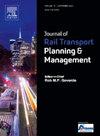Prediction of the estimated times of arrival of freight train based on operational and geospatial features
IF 2.7
Q3 TRANSPORTATION
Journal of Rail Transport Planning & Management
Pub Date : 2025-02-20
DOI:10.1016/j.jrtpm.2025.100508
引用次数: 0
Abstract
In many railway systems, freight train schedules are often adjusted based on passenger train timetables at the operational level. Predicting the estimated time of arrival (ETA) for freight trains is a challenging task due to the high variability in transit times. This study introduces ETA prediction models developed using two years of operational data combined with geospatial features for freight trains operating within a sub-network of the Iranian railway. Prediction models for all origin-destination pairs in each direction (north-to-south and south-to-north) were created, predicting ETAs at three distinct locations along the routes. Four machine learning algorithms were evaluated, and the most accurate model was determined through comparisons with a baseline statistical model. The random forest algorithm demonstrated superior performance among the models at most locations. The performance improvements of the best prediction models with and without geospatial features were also investigated. Models incorporating geospatial features showed notably higher accuracy than those relying solely on non-geospatial predictors. These improvements were particularly more evident in the south-to-north direction and at locations closer to the destination. The results of this research offer practical insights for logistics centers, enabling optimized loading, unloading, and resource allocation strategies, thereby enhancing the efficiency of freight railway operations.
基于运营和地理空间特征的货运列车预计到达时间预测
在许多铁路系统中,货运列车时刻表经常根据运营层面的客运列车时刻表进行调整。货运列车预计到达时间(ETA)的预测是一项具有挑战性的任务,因为运输时间的高度可变性。本研究介绍了利用两年的运行数据结合地理空间特征开发的ETA预测模型,该模型用于在伊朗铁路的一个子网络内运行的货运列车。建立了每个方向(北至南和南至北)所有始发目的地对的预测模型,预测了沿线三个不同位置的eta。评估了四种机器学习算法,并通过与基线统计模型的比较确定了最准确的模型。随机森林算法在大多数位置表现出较好的性能。研究了在有地理空间特征和没有地理空间特征的情况下,最佳预测模型的性能改进情况。结合地理空间特征的模型比仅依赖非地理空间预测因子的模型具有更高的准确性。这些改善在南向北方向和更靠近目的地的地方尤为明显。本研究结果为物流中心提供了实用的见解,实现了优化的装卸和资源分配策略,从而提高了货运铁路的运营效率。
本文章由计算机程序翻译,如有差异,请以英文原文为准。
求助全文
约1分钟内获得全文
求助全文
来源期刊

Journal of Rail Transport Planning & Management
TRANSPORTATION-
CiteScore
7.10
自引率
8.10%
发文量
41
 求助内容:
求助内容: 应助结果提醒方式:
应助结果提醒方式:


